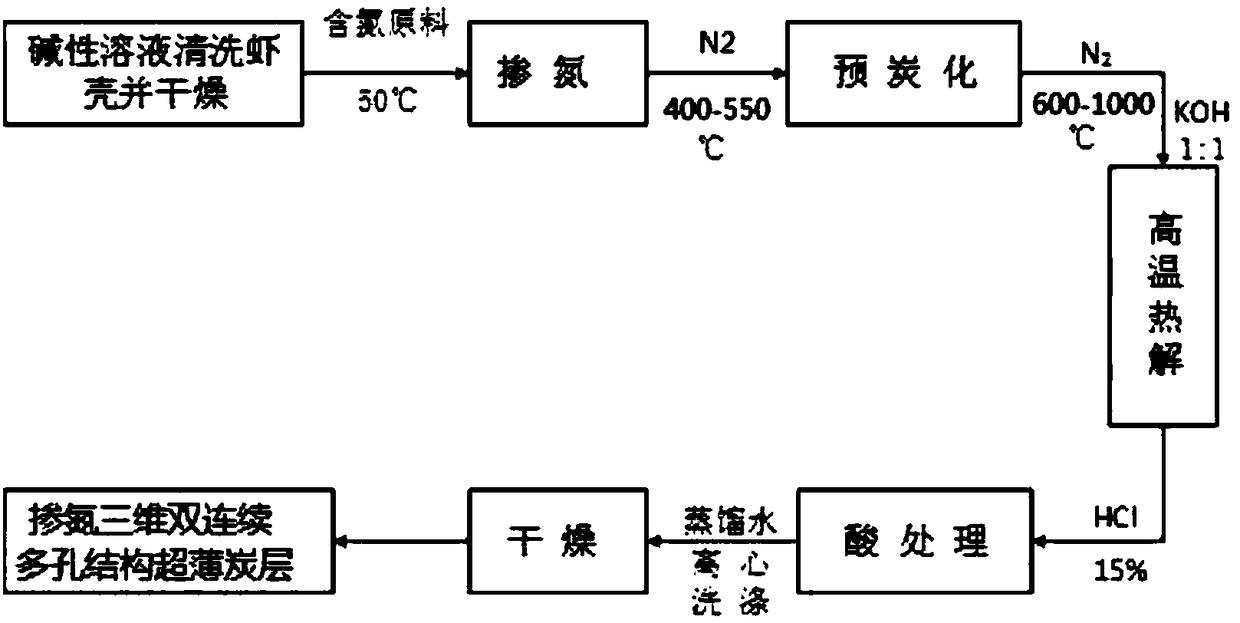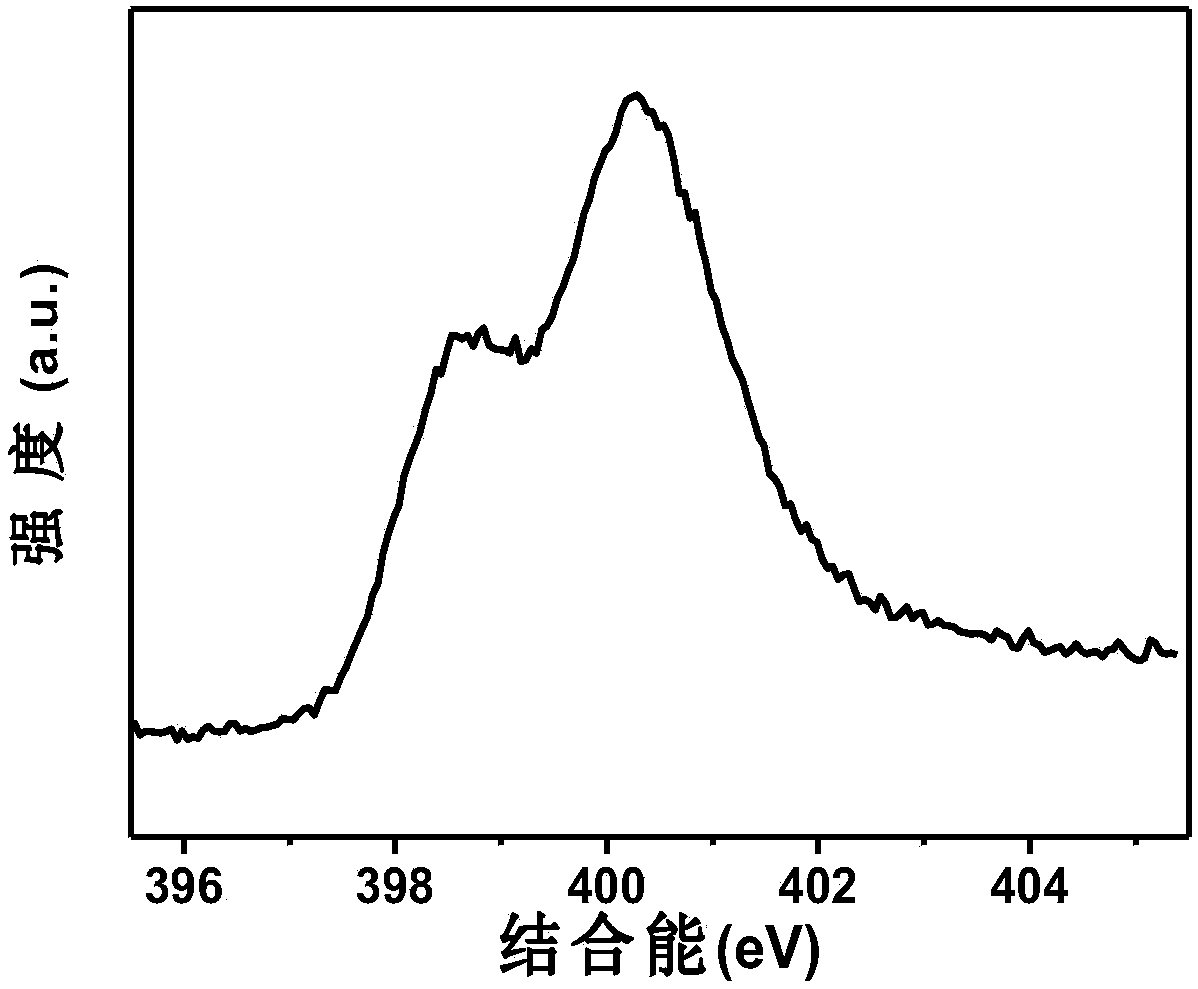Nitrogen-doped three-dimensional bicontinuous porous structure ultra-thin carbon layer and its preparation method and application
A porous structure, ultra-thin carbon technology, applied in the preparation/purification of carbon, etc., can solve the problems of complex process and high cost, and achieve the effect of simple process, low cost and wide source.
- Summary
- Abstract
- Description
- Claims
- Application Information
AI Technical Summary
Problems solved by technology
Method used
Image
Examples
Embodiment 1
[0044] Fresh shrimp shells were ultrasonically cleaned with deionized water for 3 times, then ultrasonically immersed in 10% NaOH solution for 1 h, poured off the solution, and dried in an air drying oven at 80°C for 12 h. Take 8g of dried shrimp shells and 40g of urea (mass ratio of shrimp shells and urea is 1:5) into a beaker, add 100ml of deionized water, stir magnetically to completely dissolve the urea, and heat at 50°C until the water evaporates completely. Then grind it into powder in a mortar and put it into a crucible, under the protection of nitrogen (flow rate 100mL / min), raise the temperature to 400°C at a rate of 10°C / min in a tube furnace, and keep it for 1h for pre-carbonization get the precursor. Grind and mix the low-temperature pyrolyzed substance and potassium hydroxide at a mass ratio of 1:1, put them in a crucible, place them in a tube furnace, and heat them at 10°C / min under the protection of nitrogen (flow rate: 100mL / min). The temperature was raised to...
Embodiment 2
[0050] Fresh shrimp shells were ultrasonically cleaned with deionized water for 3 times, then ultrasonically immersed in a 10% NaOH solution for 1 h, poured off the liquid, and dried in an air drying oven at 80°C for 12 h. Take 15g of dried shrimp shells, 0.15g of melamine (mass ratio of shrimp shells to melamine: 1:0.01), add 80ml of deionized water, stir magnetically to completely dissolve the melamine, and heat at 50°C until the water evaporates completely. Then grind it into a powder in a mortar, put it into a crucible, crush it, put it into a crucible, and heat it up to 450°C at a rate of 10°C / min in a tube furnace under the protection of argon (flow rate: 100mL / min). And keep it for 1h, and perform pre-carbonization to obtain a precursor. Grind and mix the low-temperature pyrolyzed substance and sodium hydroxide at a mass ratio of 1:1, put them in a crucible, place them in a tube furnace, and heat them at 10°C / min under the protection of argon (flow rate: 100mL / min). Th...
Embodiment 3
[0052] Fresh shrimp shells were ultrasonically cleaned with deionized water for 3 times, then ultrasonically immersed in 10% KOH solution for 2 h, poured off the solution, and dried in an air drying oven at 80°C for 12 h. Take dried shrimp shells and pyrrole at a mass ratio of 1:5, put them in a beaker, add 100ml of deionized water, stir magnetically to completely dissolve the pyrrole, and heat at 50°C until the water evaporates completely. Then grind it into powder in a mortar and put it into a crucible, under the protection of nitrogen (flow rate 200mL / min), raise the temperature to 500°C at a rate of 10°C / min in a tube furnace, and keep it for 1h for pre-carbonization get the precursor. Grind and mix the low-temperature pyrolyzed substance and potassium carbonate at a mass ratio of 1:3, put them in a crucible, and place them in a tube furnace at a rate of 10°C / min under the protection of nitrogen (flow rate: 200mL / min). Raise the temperature to 850°C and keep it for 1h, th...
PUM
| Property | Measurement | Unit |
|---|---|---|
| thickness | aaaaa | aaaaa |
| pore size | aaaaa | aaaaa |
| pore size | aaaaa | aaaaa |
Abstract
Description
Claims
Application Information
 Login to View More
Login to View More - R&D
- Intellectual Property
- Life Sciences
- Materials
- Tech Scout
- Unparalleled Data Quality
- Higher Quality Content
- 60% Fewer Hallucinations
Browse by: Latest US Patents, China's latest patents, Technical Efficacy Thesaurus, Application Domain, Technology Topic, Popular Technical Reports.
© 2025 PatSnap. All rights reserved.Legal|Privacy policy|Modern Slavery Act Transparency Statement|Sitemap|About US| Contact US: help@patsnap.com



